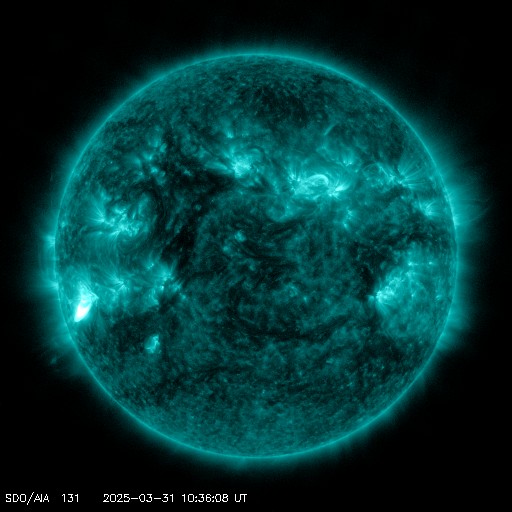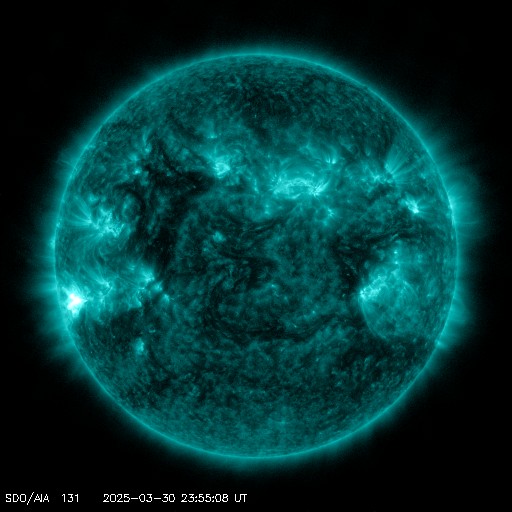Viewing archive of Thursday, 5 June 2003
Solar activity report
Any mentioned solar flare in this report has a scaling factor applied by the Space Weather Prediction Center (SWPC). Because of the SWPC scaling factor, solar flares are reported as 42% smaller than for the science quality data. The scaling factor has been removed from our archived solar flare data to reflect the true physical units.
Report of Solar-Geophysical Activity 2003 Jun 05 2200 UTCPrepared by the NOAA © SWPC and processed by SpaceWeatherLive.com
Joint USAF/NOAA Report of Solar and Geophysical Activity
SDF Number 156 Issued at 2200Z on 05 Jun 2003IA. Analysis of Solar Active Regions and Activity from 04-2100Z to 05-2100Z
Solar activity was low. There were two C-class flares
today: a C2 at 1019 UT from Region 377 (N05E57), and a C1 at 1734 UT
from Region 375 (N12E24). There was also a CME that erupted behind
the southwest limb which first became visible in the SOHO/LASCO C2
coronagraph at 2006 UT. There was a Type II radio sweep associated
with this CME. Region 375 dominates the disk in size and complexity,
and shows mixed magnetic polarities as well as an east-west
inversion line which could build up magnetic shear. However, there
is no indication of emerging flux in the region at this time.
New region number 378 (N16E69) was assigned to a small, C-type group
today.
IB. Solar Activity Forecast
Solar activity is expected to be
mostly low, but there is a fair chance for an isolated M-class event
sometime over the next three days. Region 375 is considered to be
the most likely source for energetic flare activity.
IIA. Geophysical Activity Summary 04-2100Z to 05-2100Z
The geomagnetic field was quiet to unsettled during the past 24
hours. Solar wind speed observations show a steady decline from
values around 800 km/s at the start of the period to values around
500 km/s by the end of the period. A decline in temperature was also
seen, suggesting that the Earth is moving into normal, ambient solar
wind flow. The greater than 2 MeV electron fluxes reached high
levels today.
IIB. Geophysical Activity Forecast
The geomagnetic field is
expected to be mostly unsettled, with a chance for some isolated
active periods, during the next 24 to 36 hours. Another coronal hole
will move into favorable position sometime in the next 36 to 48
hours, and conditions are expected to increase to active, most
likely beginning late on the second day and lasting through the
third day.
III. Event Probabilities 06 Jun to 08 Jun
| Class M | 40% | 40% | 40% |
| Class X | 05% | 05% | 05% |
| Proton | 05% | 05% | 05% |
| PCAF | green | ||
IV. Penticton 10.7 cm Flux
Observed 05 Jun 114 Predicted 06 Jun-08 Jun 115/118/120 90 Day Mean 05 Jun 123
V. Geomagnetic A Indices
Observed Afr/Ap 04 Jun 013/021 Estimated Afr/Ap 05 Jun 010/013 Predicted Afr/Ap 06 Jun-08 Jun 015/015-015/020-020/030
VI. Geomagnetic Activity Probabilities 06 Jun to 08 Jun
| A. Middle Latitudes | |||
|---|---|---|---|
| Active | 30% | 30% | 35% |
| Minor storm | 15% | 15% | 20% |
| Major-severe storm | 05% | 05% | 10% |
| B. High Latitudes | |||
|---|---|---|---|
| Active | 35% | 35% | 25% |
| Minor storm | 30% | 30% | 35% |
| Major-severe storm | 10% | 10% | 20% |
All times in UTC
Current data suggests there is a slight possibility for aurora to appear at the following high latitude regions in the near future
Whitehorse, YT, Yellowknife, NTAnchorage, AK, Fairbanks, AK, Juneau, AK, Utqiagvik, AK
Latest news
Latest forum messages
AR4046 136AR4048 35Solar Demon 3Unspecified geomagnetic activity 2146Aurora photography hints for those of us with smartphones 54
More topicsSupport SpaceWeatherLive.com!
A lot of people come to SpaceWeatherLive to follow the Sun's activity or if there is aurora to be seen, but with more traffic comes higher server costs. Consider a donation if you enjoy SpaceWeatherLive so we can keep the website online!

Latest alerts
10:45 UTC - Solar flare
Moderate M1.26 flare
10:27 UTC - Radio Blackout
Minor R1 radio blackout in progress (≥M1 - current: M1.22)
00:09 UTC - Solar flare
Moderate M1.03 flare
Sunday, 30 March 2025
23:51 UTC - Radio Blackout
Minor R1 radio blackout in progress (≥M1 - current: M1.03)
23:39 UTC - Solar flare
Moderate M1.52 flare
Space weather facts
| Last X-flare | 2025/03/28 | X1.1 |
| Last M-flare | 2025/03/30 | M1.0 |
| Last geomagnetic storm | 2025/03/27 | Kp5 (G1) |
| Spotless days | |
|---|---|
| Last spotless day | 2022/06/08 |
| Monthly mean Sunspot Number | |
|---|---|
| February 2025 | 154.6 +17.6 |
| March 2025 | 127 -27.6 |
| Last 30 days | 127 -25.7 |





